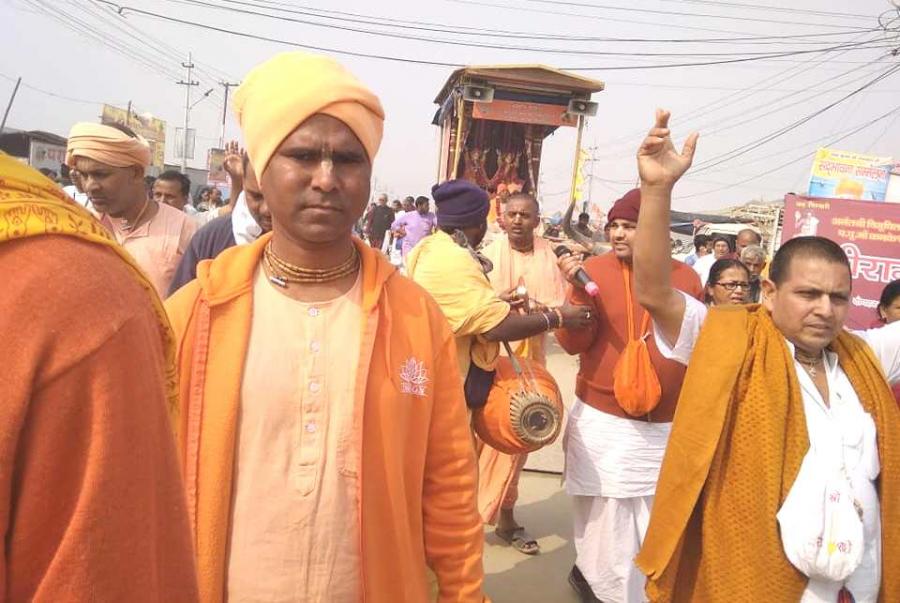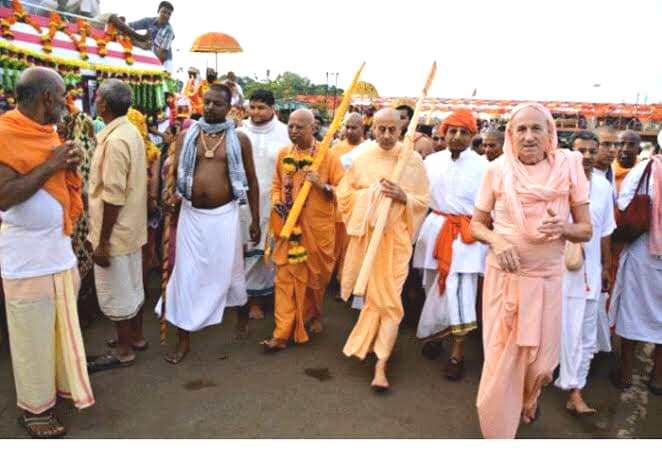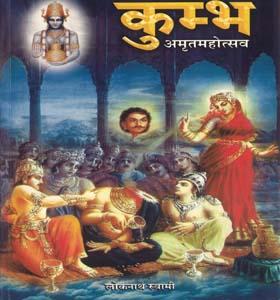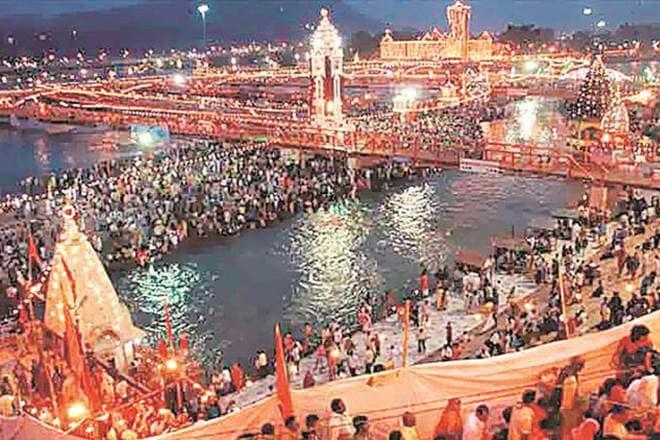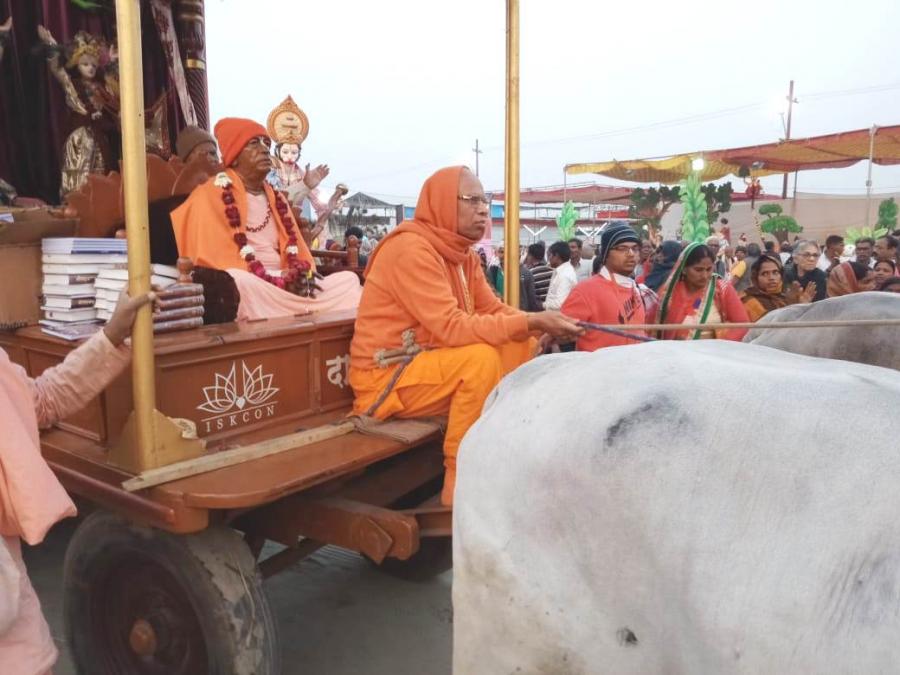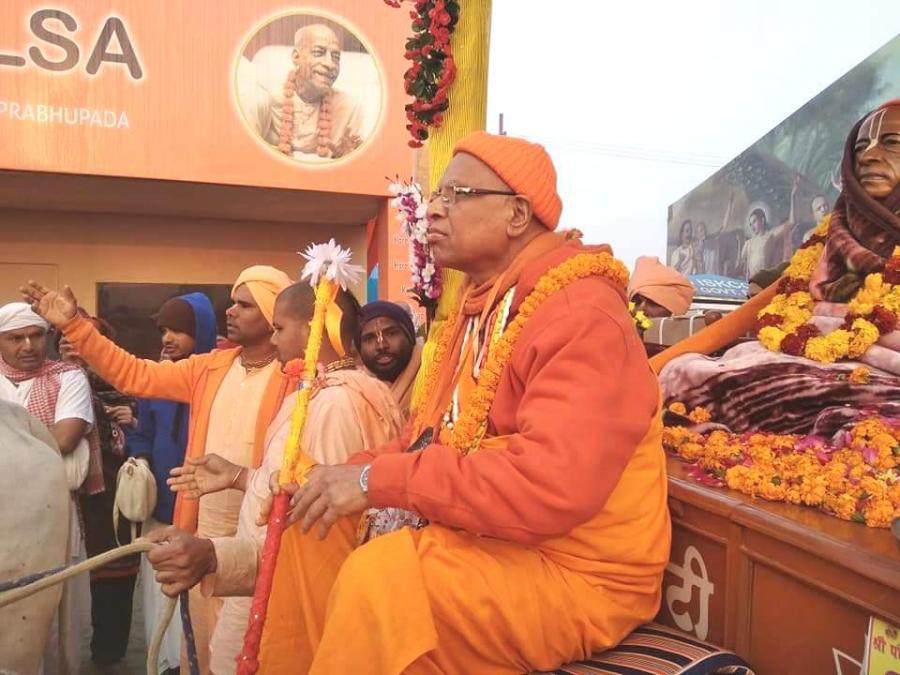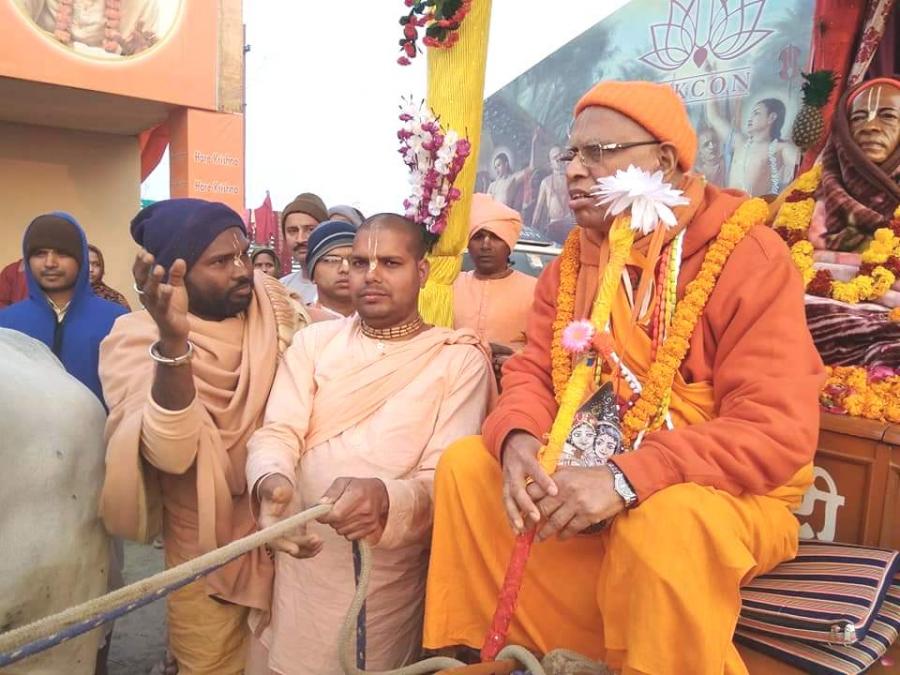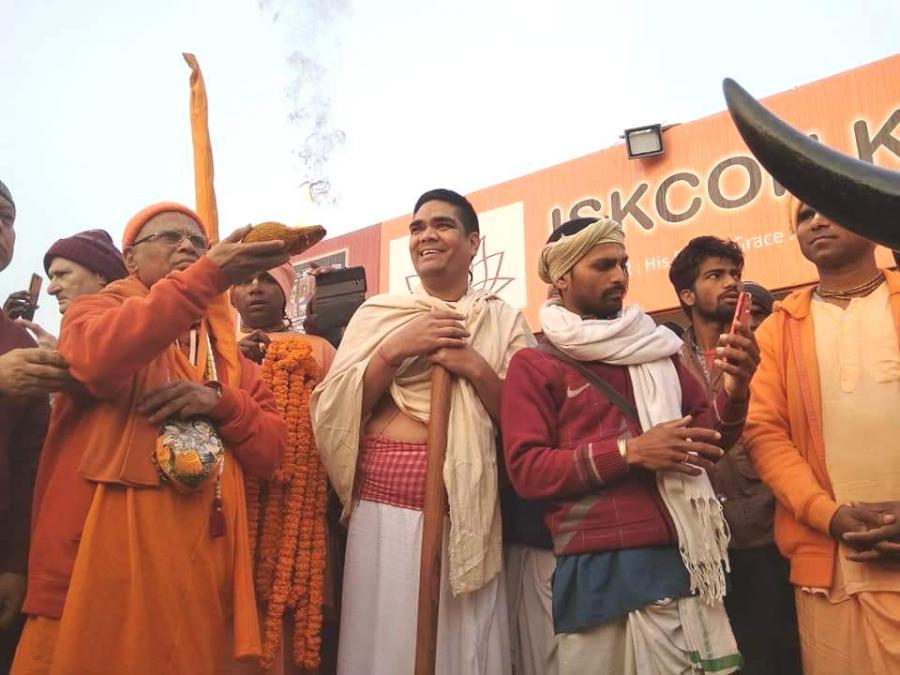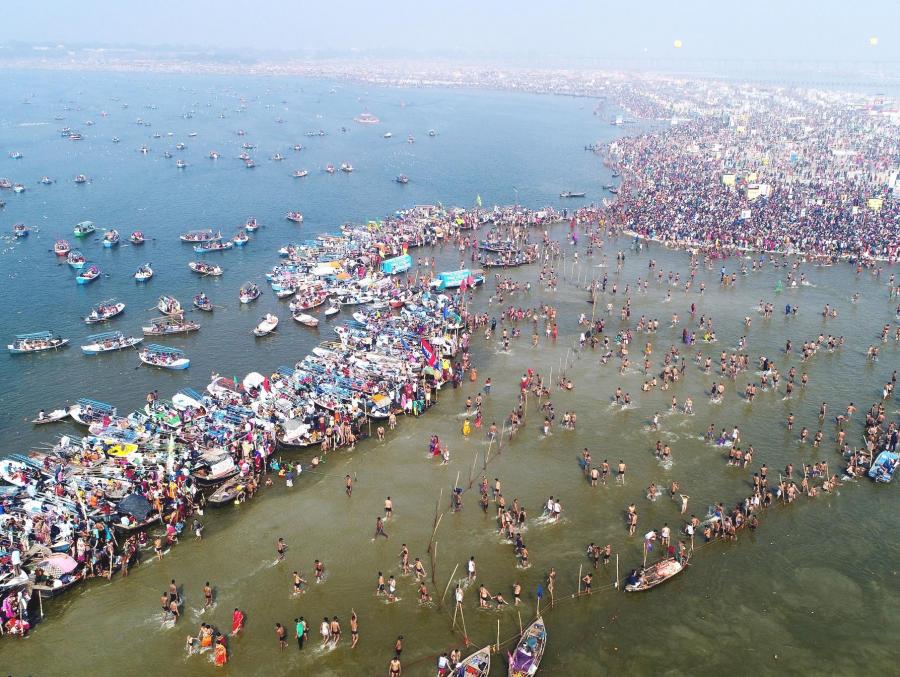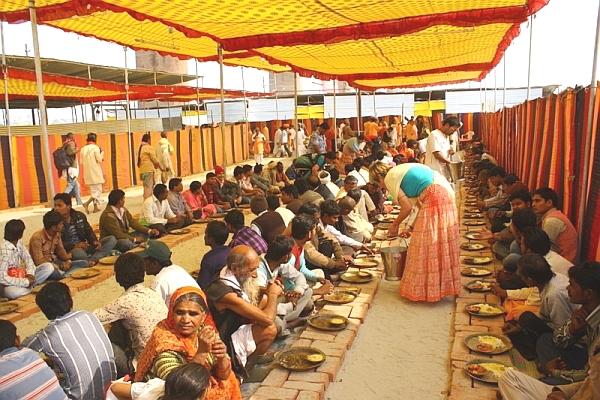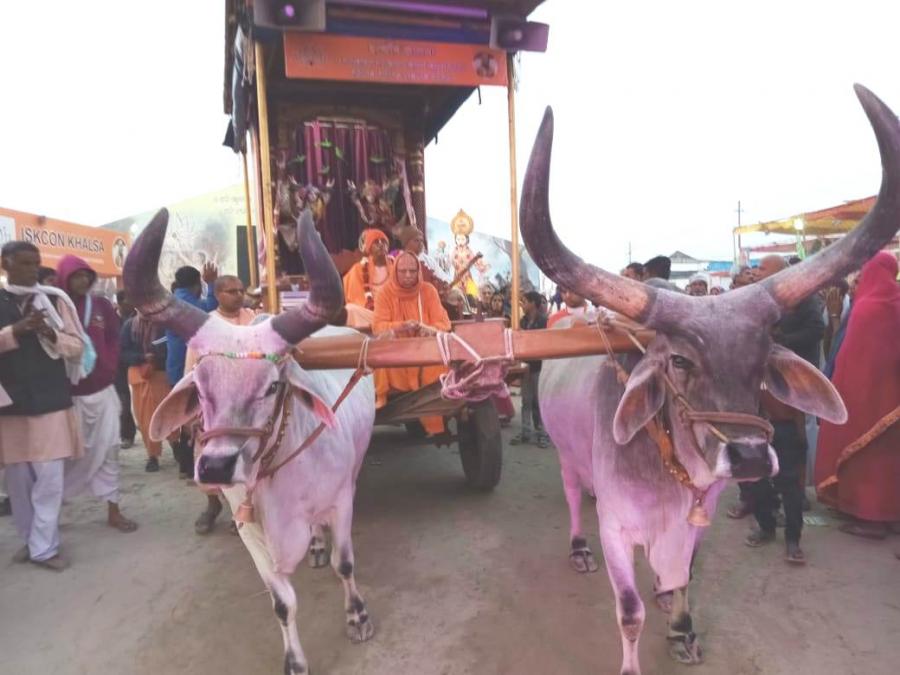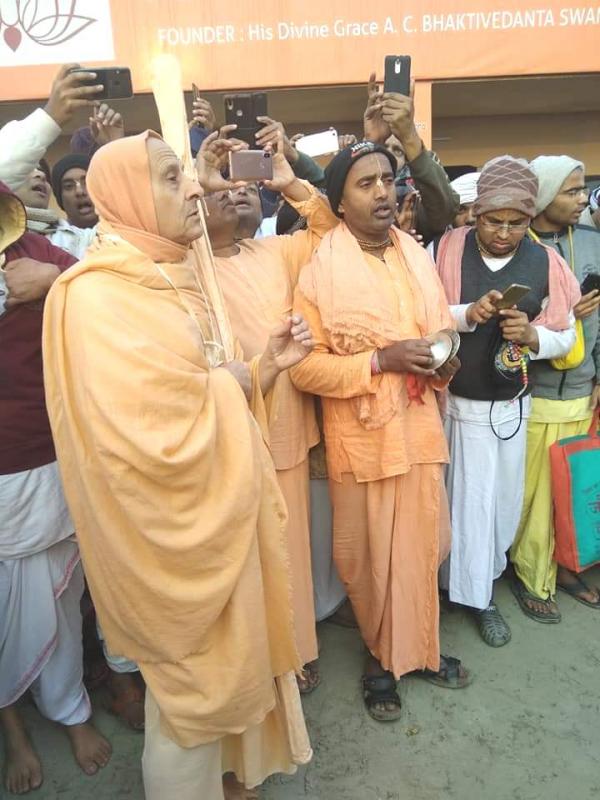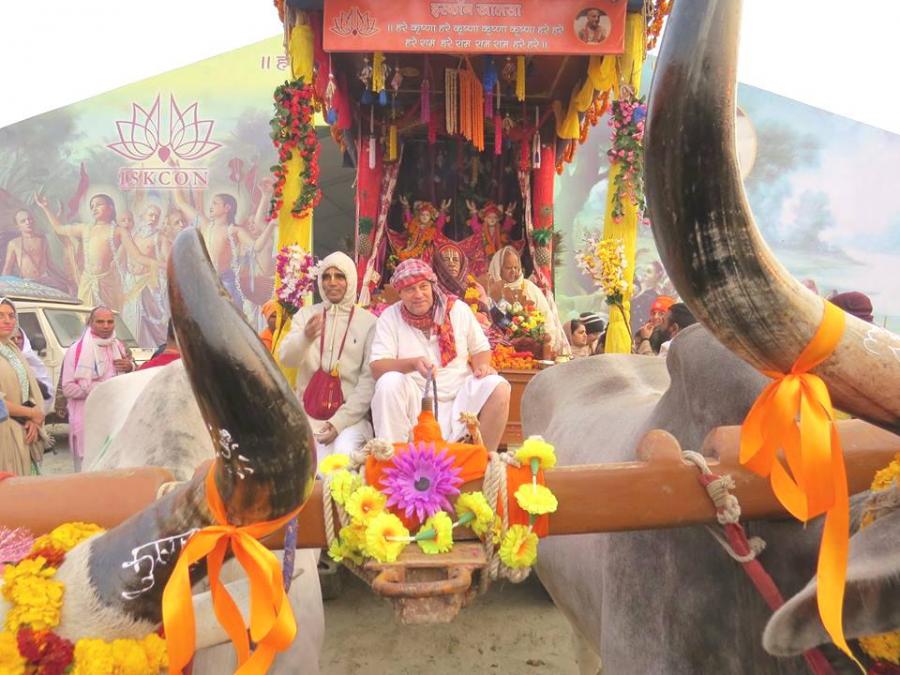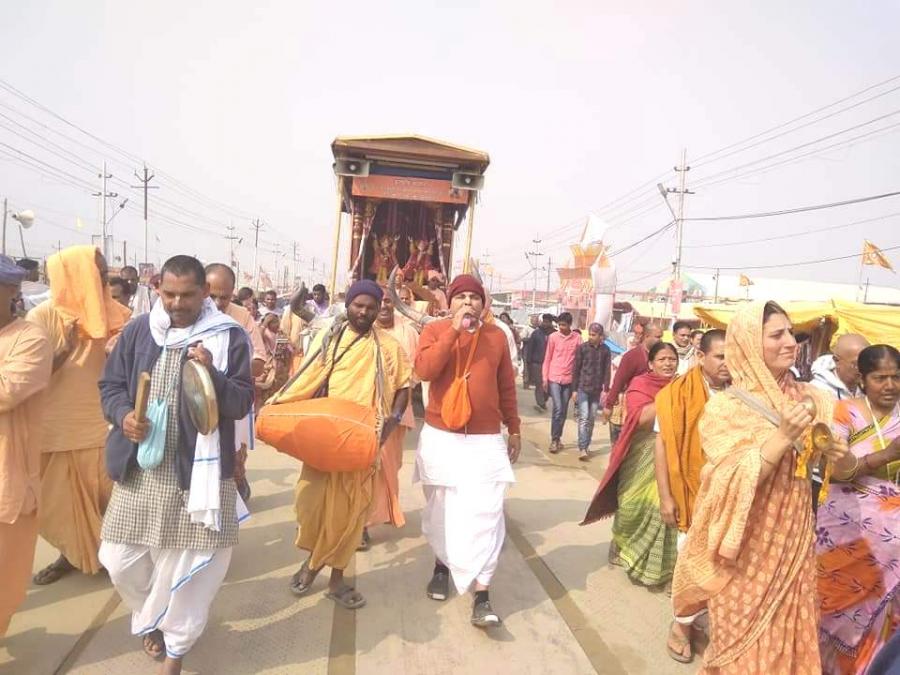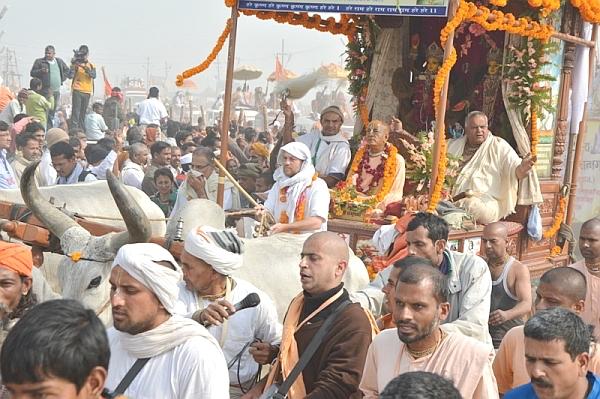By Pralhad Vatsal dasa, Bhadra Balaram dasa and Prasanna Shyam dasa
A Prayagraj (Prayag) Ardh Kumbha-mela was held at the Triveni-sangam in Allahabad, Uttar Pradesh, for about eight weeks from January 15 to March 4. All-India Padayatra leader Acarya dasa had intended for all the padayatris to be available for preaching at the mela, but it transpired that only seven fortunate souls plus AIP oxen Krishna and Vitthala – as well as the cart and Sri Sri Nitai-Gaurasundar from Pandharpur – attended the event.
A devotee asked Acarya dasa, “Prabhu, where are our two oxen?” Acarya dasa replied that they had gone to the Kumbha-mela. The devotee was surprised and said, “They are so fortunate they are attending the mela. Many humans do not get such an opportunity.” The oxen are, indeed, fortunate for Sri Sri Nitai-Gaurasundar’s mercy is always on them as they carry Their Lordships on their shoulders. Krishna is strong and never gets agitated or frightened in a crowd, and Vitthala is humble and silent, and when you pat him or caress him, he will put his head to your feet as if he is offering obeisances.
At the mela there were three Shahi Snan: Makara-sankranti on January 15, Mauni Amavasya (Somavati) on February 4, and Basany Panchami on February 10. Mauni Amavasya is considered to be extremely auspicious. On Mauni Amavasya, during which 30 million people took their bath at the confluence of the Ganga, Yamuna and Sarasvati rivers, 3000 devotees had gathered in the ISKCON camp managed by Sanak-sanatan dasa, a former AIP padayatri.
“Our schedule was a full one,” Sanak-sanatan said. “Every morning, we would attend mangala arati at 5am – a little late due to the cold. At 7:30am we would attend darshan arati, guru-puja, and Bhagavatam class, before taking breakfast prasadam. At 11am the AIP ox cart, with Their Lordships and Srila Prabhupada murti, would travel 10km around the mela with a big kirtan.”
As some devotees chanted, others would sell small books to festival-goers for thirty rupees each, along with a free copy of Bhagavad-gita As It Is. Meanwhile, at the ISKCON camp Western devotees preached Krishna consciousness from a tent containing electronic moving dioramas depicting pastimes of Lord Krishna and His avatars.
ei-mata cali’ prabhu ‘prayāga’ āilā
daśa-dina triveṇīte makara-snāna kailā
Śrī Caitanya Mahāprabhu finally arrived at Prayāga and for ten successive days bathed in the confluence of the Rivers Yamunā and Ganges during the festival of Makara-saṅkrānti [Māgha-melā]. [Sri Caitanya-caritamrta Madhya 18.222]
The word triveṇī indicates the confluence of three rivers – the Ganges, Yamunā and Sarasvatī. At present the Sarasvatī is not visible, but is said to flow from the mouths of saints who enlighten the pilgrims with knowledge of the Supreme Lord.
The Vedic literature states that whoever bathes in the Triveni-sangam at the auspicious time of the Kumbha-mela is guaranteed liberation from birth and death. That is why the mela has always attracted millions of pilgrims. Yet Srila Prabhupada said, “We are not interested in liberation. We have come to preach devotional service. Being engaged in Krishna’s unalloyed devotional service, we are already liberated.” The devotee’s only ambition, therefore, is to enlighten as many people as possible.
Lokanath Maharaja at the Kumbha-mela
“I am here in Prayag to attend Kumbha-mela. You will be inspired to know that even Caitanya Mahaprabhu attended Kumbha-mela here in Prayagraj. It was an Ardh Kumbha-mela that time. It was an annual Magha-mela. He did take the holy dip, but that was not satisfying so He chanted Hare Krishna Hare Krishna Krishna Krishna Hare Hare, Hare Rama Hare Rama Rama Rama Hare Hare.
“Ganga is flowing here and Yamuna is also flowing, but there is no flood. In the month of Magha there is never a flood. But as Mahaprabhu chanted and danced, there was a flood. He flooded the whole of Prayagraj and surrounding areas with harinama. In that Magha-mela everyone was floating in the nectar of the holy name. Caitanya Mahaprabhu drowned everybody in the flood of the nectar of the holy name. He continues to flood the whole world. He is still chanting and we are also chanting with him. We shall remember that naam nache jiva nache, nache prem-dhan. (Hari-nama-cintamani: 1.2.58) As we chant the holy name of the lord, you the living entities are dancing, the holy name is dancing, Gauranga is dancing. We have come here in Kumbha-mela.
“Prabhupada had also come, I was there with him in 1977. He said, ‘We do not come to Kumbha-mela aspiring for amrta from the kalash, or nectar that emerged with the churning that took place and the same nectar that emerges on particular dates. There will be millions of seekers of nectar. There are already many of them gathered here to swim in that amrit. But we don’t come here for that. We come here to chant. We come here to preach the holy name of the Lord. To chant the glories of the holy names of the Lord, pastimes of the Lord, form of the Lord. By this we make another kind of nectar available to the pilgrims here. To compare the Kumbha-mela amrit with that of Namamrit is an offence. This is the eighth offence. To consider harinama as one of the ritualistic activities mentioned in the Karma-kanda sections of the Vedas. So that nectar cannot be compared, but trying to compare also is an offence.’
“There are hundreds and thousands of camps here, like a new township on the bank of the Ganga-Jamuna. But among all those camps, ISKCON’s camp, Caitanya Mahaprabhu’s camp, is the best, representing Brahma-madhva-Gaudiya sampradaya, which is the super-excellent school of thought. Otherwise every one over here is doing ‘yat mat tat’ path.
“There is a whole township here on the banks of the Ganges, chanting and dancing and distributing prasada. Devotees are busy here giving out the real nectar. The holy name is the nectar. Holy books like Bhagavad-gita are the nectar. Krishna prasada is the nectar. Here we are surrounded by lots of Hare Krishna devotees chanting and dancing. Being an ISKCON mahant for Kumbha-mela, I have to lead the procession, for Shahi Snan. It’s an honour from Kumbha-mela organisers. They have recognized ISKCON as an authentic vaisnava organisation. It was recognised, authorised in 2008 Kumbha-mela. ISKCON was offered mahantship. That’s how I ended up becoming a mahant. Now we can participate in the procession. Many groups, akhadas, khalsas, arrive. Only big leading sadhus get to lead the procession to go down to the Triveni-sangam. People watch standing on either side of the procession. There are big crowds greeting the sadhus, trying to get blessings of the sadhus.”
Book distribution: At the mela the Noida, Panjabi Bhag and New Delhi teams joined forces to distribute Srila Prabhupada’s Bhagvad-gita As It Is. An additional attraction was the Kumbha book by Lokanath Maharaja, which informs devotees about the history of the Kumbha-mela and recalls Srila Prabhupada’s involvement in the festival. It is the book for anybody even remotely interested in this ageless event. Book scores: 20,800 Bhagvad-gita; 17,600 Kumbha (Hindi copies); 858 Kumbha – The Festival of Immortality (English copies); Total 39,258.
Harinama sankirtan: We did sankirtan daily from 5am to 7 pm, and as we moved through the festival many other pilgrims joined us. Ours was the only bullock cart with oxen in the mela, attracting everyone’s attention.
Prasadam distribution: The kitchen tent ran from 6am serving free prasadam meals of rice, dahl, subji, chapatti and sweets, all cooked in ghee, to 2000 people every day. On the first day, Makara-sankranti, prasad was served to 5000 people and on Mauni Amavasya to 10,000 people, including the devotees.
During the main bathing days devotees mingled with other holy men and on Mauni Amavasya participated in the day’s biggest procession with their padayatra cart. Each day concluded with a 7pm arati and kirtan followed by another chance to hear from saintly persons, as instructed by Srila Prabhupada. Speakers included Lokanath Swami, Radhanath Swami, Vedavyasa Priya Swami, Prabhodananda Sarasvati Swami, Radha Ramana Swami, Sarvabhauma dasa, and Gopal Krishna Goswami.
The AIP padayatris who attended the Kumbha-mela were Badra Balaram dasa, Prahlad Vatsal dasa, Damodhar Lila dasa, Kuanteya Sakha dasa, Uttam Narahari dasa, Prasanna Shyam dasa, and Rutadvipa Gaurachandra dasa.

